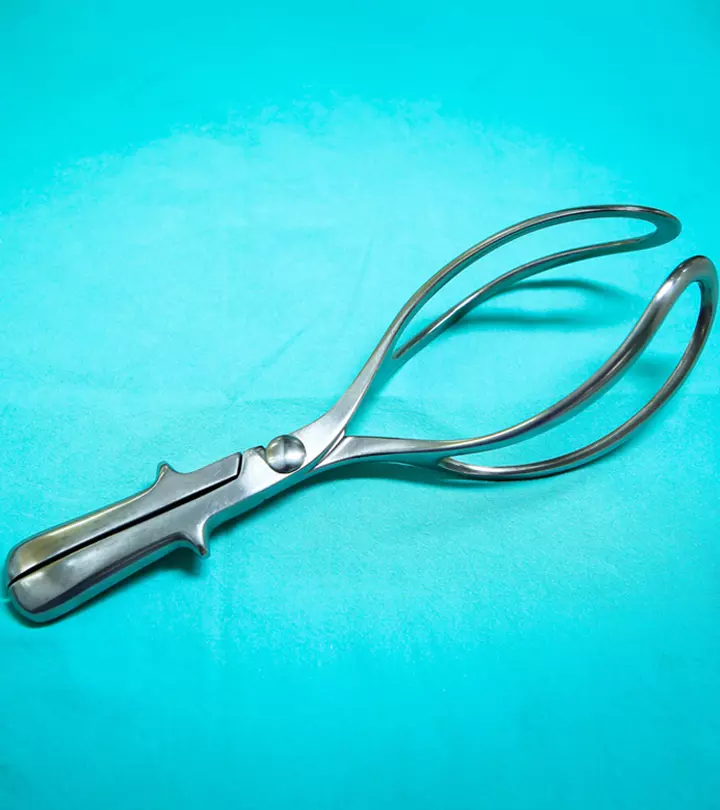
Image: Shutterstock
Bringing a new life into the world is a miraculous journey, often marked by moments of uncertainty and unexpected turns. Forceps delivery is one such twist that may occur during childbirth. While it might sound intimidating, understanding what forceps delivery entails can help ease any concerns you may have. In this article, , we’ll take you through the ins and outs of forceps delivery, shedding light on its purpose, procedure, risks, benefits, and recovery. Read on to know more!
- What Is Forceps Delivery?
Forceps delivery is a medical intervention that is utilized when difficult circumstances arise during childbirth that necessitate additional assistance. These circumstances could include prolonged labor, maternal exhaustion, or concerns about the baby’s well-being. The forceps themselves are carefully designed instruments resembling large, curved spoons with padded edges to ensure a secure yet gentle grip on the baby’s head.
During the procedure, a skilled obstetrician skillfully applies the forceps to the baby’s head while the mother remains under anesthesia to minimize discomfort. With each well-timed contraction, the obstetrician guides the baby through the birth canal, aligning their position for a smoother exit into the world. This delicate maneuver requires precise expertise to ensure both the mother and the baby remain safe throughout the process.
While the term “forceps” might sound intimidating, it’s important to understand that their use is a well-practiced and carefully monitored technique designed to alleviate potential complications and ensure a positive outcome. The procedure aims to minimize stress on the baby during what can be a challenging journey through the birth canal. It also reduces the strain on the mother, particularly in cases of prolonged labor.
- How Common Is Forceps Delivery?
Image: Shutterstock
While the majority of childbirths proceed without the need for forceps, they are utilized in approximately 1-7% of all deliveries (1). Medical professionals may recommend a forceps delivery when certain conditions or complications arise that could potentially put the baby’s or mother’s health at risk.
- What Causes You To Have Forceps Delivery?
Forceps delivery may be recommended under various circumstances, such as:
1. Slow Progress
If labor is progressing slowly, medical professionals might opt for forceps assistance to prevent prolonged distress for both the baby and the mother.
2. Fetal Distress
When there are signs of fetal distress, such as an abnormal heart rate, forceps delivery could be necessary to swiftly extract the baby and ensure their well-being.
3. Mother’s Exhaustion
Prolonged labor can lead to maternal exhaustion. Forceps delivery can help expedite the process, reducing physical strain on the mother.
4. Malpositioned Baby
If the baby is not positioned optimally for a safe vaginal birth, forceps can be employed to guide the baby into a better position.
- How Is The Procedure Performed?
Image: Shutterstock
The procedure is typically carried out in a hospital setting by skilled obstetricians. Prior to the procedure, you may receive anesthesia, which can be either regional (epidural) or general, to minimize discomfort.
During the delivery, the obstetrician carefully inserts the forceps around the baby’s head, ensuring a secure grip. With each contraction, gentle traction is applied to guide the baby’s head through the birth canal. It’s essential to note that forceps delivery is a delicate process, and the medical team should be well-trained to ensure the safety of both you and your baby.
- Risks Vs. Benefits Of Forceps Delivery
As with any medical intervention, forceps delivery comes with its own set of risks and benefits.
- Benefits
1. Quicker Delivery
Forceps delivery can expedite a prolonged labor, reducing stress on both the mother and the baby.
2. Reduced Need For Cesarean Section
Forceps delivery can sometimes prevent the need for an emergency cesarean section.
3. Minimized Fetal Distress
By facilitating a faster delivery, forceps can help alleviate fetal distress and potential complications.
- Risks
1. Perineal Tears
Forceps delivery may increase the risk of perineal tears or lacerations.
2. Bruising Or Swelling
The baby’s head may experience temporary bruising or swelling due to the forceps.
3. Maternal Discomfort
Forceps delivery can lead to postpartum discomfort for the mother.
- Forceps Delivery Vs. Vacuum Delivery
Forceps delivery shares similarities with vacuum extraction, another technique used for assisted childbirth. Both methods aim to assist in the delivery process. However, forceps utilize a grasping mechanism, while vacuum extraction employs suction to attach to the baby’s head. The choice between the two methods depends on the specific circumstances of the delivery and the expertise of the medical team.
- Recovery
Image: Shutterstock
Following a forceps delivery, your medical team will closely monitor both you and your baby for any signs of complications. You may experience some discomfort or soreness in the perineal area, which can be managed with pain medications and proper postpartum care. It’s essential to follow your healthcare provider’s instructions for a smooth recovery.
Childbirth is a remarkable journey filled with unpredictability and moments of awe. Forceps delivery, while not the norm, can sometimes be a necessary step to ensure the health and well-being of both the mother and the baby. By understanding the procedure, its benefits, risks, and potential alternatives, you can approach the childbirth experience with a sense of knowledge and preparedness. Remember, your healthcare provider is your greatest ally, guiding you through the process with expertise and care.















